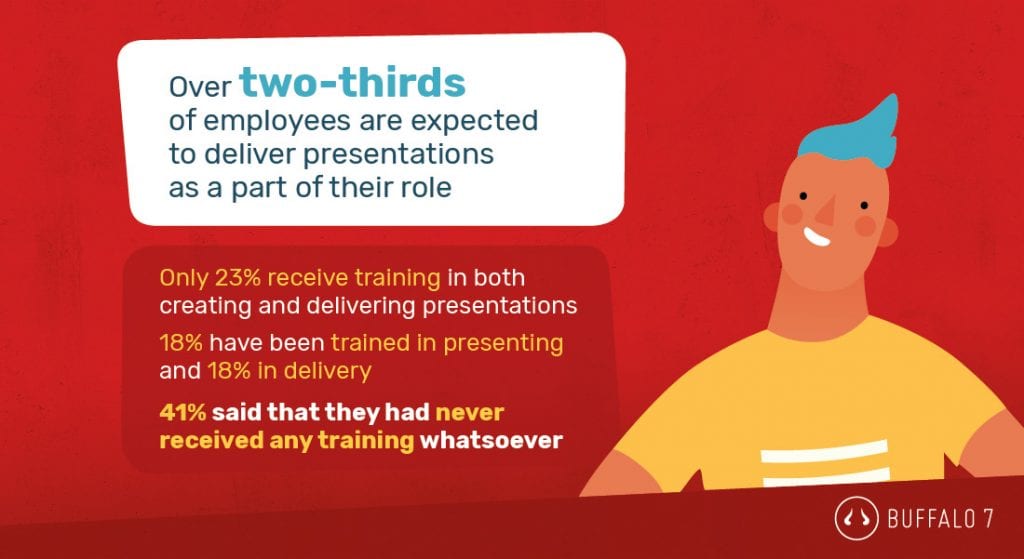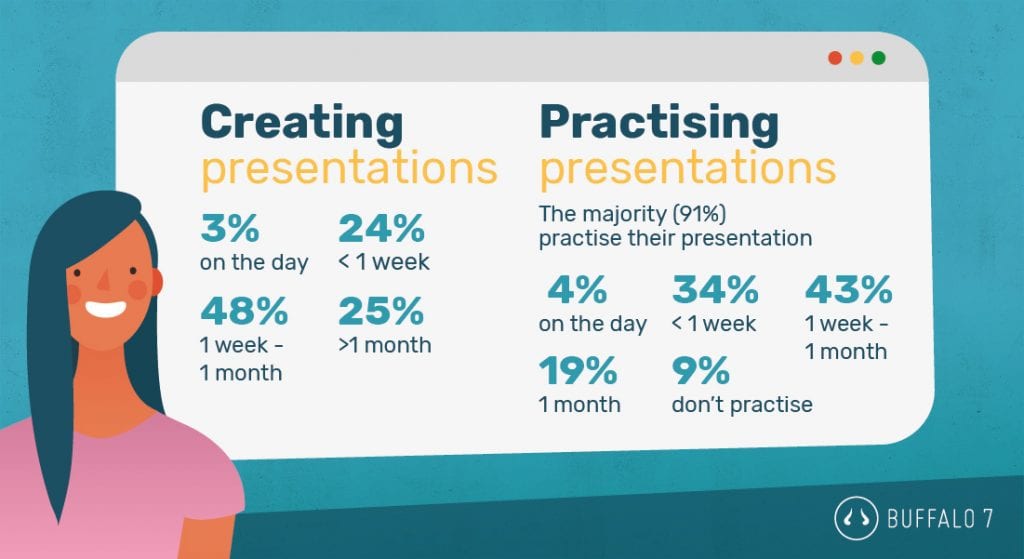It’s no surprise to us that most office workers in the UK will have to create and deliver a presentation at some point in their working lives. In the world of business, presentations are a driving force. They’re used to pitch ideas, get new business, share experiences, change minds, teach new concepts and inspire people to take action.
At Buffalo 7 we work on these types of presentations all day every day, so we have a solid understanding of the different forms a presentation can take. The tonality, the structure, the methodology and the style of delivery – we’re all different and we all like to convey our ideas in our own way, using our own unique skills.
We wanted to deepen our understanding of people’s presentation skills by finding out just how seasoned and well versed the average UK employee actually is when it comes to delivering a killer presentation. It’s a skill that’s high in demand, but how many people are actually competent enough to present successfully? How comfortable do people feel when they’re standing up there alone facing a legion of strangers?
To get this information straight from the horse’s mouth, we decided to carry out a survey of just over 1,000 office workers from across the country. We used this opportunity to quiz them about their knowledge of presentations and the level of training they’ve received. Here’s what we found out.
UK presentation training statistics

One point that the survey reaffirmed is just how popular presentations are within the working world. 77% of employees who responded to our survey said they are expected to deliver presentations as part of their role. No surprise there really, but what was surprising to us was how few of these employees had actually received professional training to do this.
Only 23% of our respondents said that they’d received training on creating and delivering a presentation, which is odd, considering how important they are in shaping an audience’s perception of a brand. Get it wrong or give a botched, half-assed attempt and you can tarnish your reputation within seconds. Think about it in another scenario: would you send a new employee to an important client meeting without training them first?
We wanted to dig a little bit further, so we asked them what type of training they’d received. 18% expressed that they’d been trained exclusively in presentation creation, while another 18% highlighted that they’d only been trained in presentation delivery. Out of all respondents, a startling 41% stated that they hadn’t received any training whatsoever. This was news to us.
Training by region
Another angle we wanted to take a look at was regional differences. Is presentation training more popular in certain regions of the UK than others? When we looked at the results, the area that had the lowest number of trained employees was Northern Ireland, with 57% of the sample group revealing they’d never been trained.
The most trained, presentation-savvy region of the UK turned out to be the East of England.
32% told us they had been trained in both creating and delivering presentation, which was a significant proportion in comparison to other regions.
Presentation preparation UK statistics

Preparation is one of the key components for a successful presentation but it seems to be undervalued by a lot of presenters – which is odd when you think about how important it is to practice for anything important really. Practice makes perfect, no? Of all the people who responded, a measly 25% of people said they prepared for their presentations in advance. As an agency who actively share preparation tips with our clients and encourage them to prepare, this was not music to our ears.
When asked how far in advance they prepared, 25% said they began preparing about a month in advance but most people said they prepared about a week before the big day (48%). Surprisingly, 3% of people began preparing on the day they were to deliver their presentation (that’s 3% too many to us and a recipe for disaster if you’re the average presenter).
But what about actually practicing the delivery of the presentation? We put respondents to the test and 9% failed it, saying they never practiced at all. On a positive note, 47% said they always practiced, with the other 44% going to people who practice occasionally.
Of those who said that they did practice, 19% started more than a month before the date of their presentation, 43% began less than a month but more than a week before, 34% said they practiced less than a week in advance and 4% admitted to only doing so on the same day.
Common presentation introduction approaches

The importance of a presentation opening can’t be understated. You have a few moments to capture their attention, make a first impression and hook them with what you say. So, how do most people typically start their presentation? We found out.
The results varied. 32% of the people we spoke to said that they opened their presentation by introducing themselves and their team, while 25% simply introduced themselves.
The others adopted a totally different style, choosing to take a more light-hearted route. 10% decided to start things off with a touch of humour by telling a joke, while 10% chose to assure people that the presentation wouldn’t take too long. 6% sweetened up their audience by handing out chocolates, biscuits or other treats, while 4% made a comment about the weather.
9% chose to reject all the formalities altogether, and dive straight into the good stuff without even starting with an introduction. Bold move.
Presentation mishaps

Nerves are perfectly natural before a presentation. As humans, our minds seem to fixate on all the things that could go wrong. There’s always room for slip ups when you’re stood alone on a stage facing a room of people but odds are, it’ll go much smoother than you initially thought. Most employees have experienced one or more of these in their lives and most come out the other side relatively unscathed. Here’s a lowdown of the most common mishaps of our participators:
- 35% mentioned that they’d experienced technical difficulties relating to their computer, projector, or trying to transfer or load a file that was too big
- 33% found themselves having to make last minute changes
- 27% spotted a typo on one of their slides while they were presenting.
- 18% discovered that members of their audience did not understand the information they were trying to deliver
- Another 18% found that nerves got the better of them and they were unable to deliver their presentation at all
- 15% admitted delivering presentation they have NEVER seen before as someone else created it for them
- 12% experienced an audience member walking out
- 11% were forced to deliver an incomplete or unfinished presentation
- 10% ended up delivering an old version of their presentation
Only 13% told us that they had never experienced a single hitch with their presentations.
Presentation quality and business performance

Of course, a lack of training or preparation can lead to something much worse than a few minor hitches on the day. Of the employees we spoke to, 26% said that their company had lost a potential customer because they delivered a poor presentation, and 39% of those individuals admitted that it had happened more than once.
It goes even more downhill from here. 25% had seen an existing customer cut ties with their organisation because of a problem with a presentation, and 44% of these respondents said that this had happened on multiple occasions. Presenters shouldn’t be taking any risks. If you want to enrapture your audience and bring them on board with your ideas, you’ve got to step up your preparation game. The solution to this is simple: prepare, practice and then practice again.
As you can see from the above, proper presentation training plays an important part in helping your employees maintain the consistently high standard that you expect. Employees will only be the best possible ambassadors for you company if you train them to be. Step it up.
For more information and statistics feel free to get in touch with our team.


